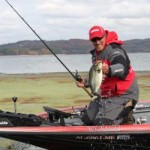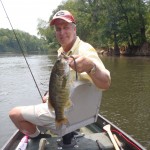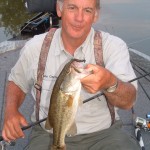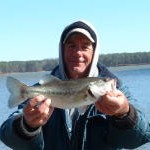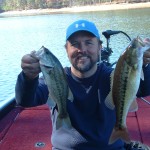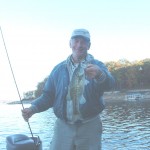
Rainy day bass
Pity the poor bass fisherman in Georgia. There are so many good bass lakes around the state he just doesn’t know where to go. All the options make it tough to decide which way to head to catch bass. What a terrible problem to face!
From our beautiful mountain lakes with steep rocky shorelines, clear water and aggressive spotted bass to flatland reservoirs full of stumps, grass and largemouth, we have it all. Good fishing will always be within a short drive of a Georgia bass fisherman. And it is always fun to take a trip to a lake on the other end of the state to try something completely different.
Any lake in Georgia will produce good catches but how do you decide which lake to go to if you want to improve your odds? A good pointer is the Georgia Bass Chapter Federation Creel Census Report compiled by Dr. Carl Quertermus at the University of West Georgia. He has been crunching the numbers reported by Georgia bass clubs since 1978. His data can give you an excellent guide.
First, you need to decide if you want to catch big bass or numbers of bass. Although you can do both at times, some lakes will always produce bigger than average bass but they usually produce lower numbers per angler hour. Others will consistently produce more bass for you but their size will not be as good as on other lakes.
The following lakes will give you some good choices. You won’t go wrong with any of them, no matter what your bass fishing goals.
Lake Thurmond – Clark’s Hill
Lake Thurmond, better known at Clark’s Hill to Georgia fishermen, is by far the most popular destination for state bass clubs. There were 125 tournaments reported there during the most recent creel census annual report. The next most popular lake, Sinclair, had 76 tournaments reported.
There is a reason Clark’s Hill is so popular – it produces excellent numbers of good size bass. The average catch rate per man hour of bass fishing there was .306, meaning it took just over three hours to produce a keeper. That doesn’t sound great, but it is the third highest catch rate in the report. Since there are so many tournaments there that is a lot of bass.
The average size of bass from Clark’s Hill is 1.77 pounds, not huge but the second highest for a lake with a 12 inch size limit. And there are good numbers of five-pound plus bass in the lake. It took 225 hours of fishing to produce a bass over five pounds, second shortest time in the state. A few spots are showing up in Clark’s Hill and may hurt the fishing over the long run, but right now the numbers and size of bass make Clark’s Hill one of our best lakes to fish.
Dammed in 1950, Clark’s Hill is our biggest lake with 72,000 acres of water covering the Savannah and Little River basins just north of Augusta. It is the last of the chain of lakes on the Savannah and the terrain the lake floods is rolling hills with creek and river channels. The lake is big enough to offer just about any kind of fishing conditions you want, from very clear to muddy water, deep drops to shallow flats and even hydrilla to fish.
The hydrilla is a fairly new addition to the lake as are blueback herring. Both have changed the lake. The hydrilla offers extensive heavy cover where little existed fifteen years ago and the blueback have become a favorite food for the bass.
When the bluebacks are spawning in April you can catch large numbers of quality bass throwing big topwater plugs like a Zara Spook, soft jerkbaits like a Zoom Fluke and wake baits like the Buckeye Lures Wakeup over shallow gravel flats. The Georgia Little River arm of the lake is excellent for this, with many blow-throughs, shallow gravel bars between islands, where the blueback spawn.
After the sun gets bright and the blueback disperse, dragging a Carolina rigged lizard on gravel flats and points produces good catches. On bight sunny days pitching a jig and pig into holes in the hydrilla and popping it back can produce quality bass. And, if the lake is full, dropping a Texas rigged worm around button bushes in the shallows if a fun way to catch fish.
Lake Allatoona
The lake with the highest catch rate in the state is always a surprise, but Lake Allatoona consistently holds that position. Although the number of tournaments there is low, they produce a catch rate of .352, the highest in the state. Allatoona has been consistently in the top lakes in the state for numbers of bass per hour for several years.
Size of bass is good, too, with the average bass weighing 1.75 pounds. But it is tough to catch a five pound plus bass. None were reported in the most recent creel census report. Since spots account for 90 percent of bass weighed in, that is not surprising, and a 1.75 pound average for spots is impressive.
Located almost in downtown Atlanta, Allatoona gets real crowded and is hard to fish during the warmer months, except at night. Just over 12,000 acres of water cover steep rocky hillsides and flats up the Etowah River. Filled in 1950, it is just 30 miles north of Atlanta and I-75 crosses it.
The lake is full of spotted bass and the steep rocky banks and points are great habitat for them. The lake is small enough that water levels change rapidly. A heavy rain will over-fill the lake but it will be pulled down just as fast. And the average 17 foot drop for winter pool means there is not much shallow cover except rocks and man-made brush piles.
Your best bet to catch spots on Allatoona is to get on the rocky bluff banks and fish them. You can parallel them with a crankbait while the water is still cool, keeping you boat in close and running your bait along the steep drop. Hopping a jig head worm or small jig and pig down the rocks also works well.
Topwater early in the morning fished along the steep rock walls will draw strikes until the sun gets on the water. From big baits like a Spook to small ones like a Tiny Torpedo, spots will hit topwater hard. Some days they want a small bait, sometimes the big one, so give them a choice.
As the water warms ride points, humps and channel drop and watch your depthfinder for brush piles from 18 to 30 feet deep. Mark them, back off and drag a jig head worm or jig and pig through them. On the more shallow ones run a big crankbait over them if you can get it down to within a couple of feet of the top of the brush. It is even better if you can tick it.
Lake Blackshear
Often overlooked by bass fisherman, Blackshear has the highest average size for largemouth of all lakes in the Creel Census Report, at 2.26 pounds. There aren’t a lot of tournaments reported on the lake but that average size is impressive. And it takes only 261 hours to catch a five-pound plus bass, third lowest time in the state.
Numbers of bass caught is what often holds fishermen back from going to Blackehear. It takes about six hours of club tournament fishing to produce a bass, the longest time in the state, but the size is likely to be good. And the cover you get to fish makes Blackshear a fun lake to fish.
Located near Cordele not far from I-75, Blackshear is in the middle of the state. Its 8500 acres on the Flint River cover swamps and bottom land and the lake is very shallow. Dammed in 1930, it is a very old lake but it was drawn down in 1973 and much of the standing timber was removed from the main lake below the Highway 280 Bridge. The flood in 1994 broke the dam and it was rebuilt, renewing the lake for few years.
If you like fishing cover for largemouth you will love Blackshear. Its shallows are filled with cypress trees and various kinds of aquatic grass. Bass hold tight to this cover but it is fun fishing visible targets rather than dredging unseen depths.
Pitch a Texas rigged plastic worm or jig and pig to the base of a cypress tree and let if fall. Work it slowly through the root ball. Remember the roots of a cypress often extend several feet from the base of the tree and bass will hold anywhere in them.
A key to fishing cypress trees is to hit the trunk of the tree and let your bait slide into the water. A splash seems to turn off the bass holding so shallow. Use heavy tackle. You are likely to tangle with a two to five pound bass in this thick cover.
If you like topwater, the grass filled shallows are fun to fish, too. Use weedless baits like a frog or rat and work matted vegetation. You can also run a buzzbait over submerged grass, through holes and channels in grass and beside cypress trees. All methods will produce water splashing strikes.
Lake Seminole
The best bass lake in Georgia for big bass should come as no surprise. Seminole has long been known as the land of lunkers and the Creel Census Report shows it still produces the best fishing for quality bass in Georgia. It is well worth the trip south to experience its fishing and beautiful scenery. It has a few spotted bass in it and shoal bass can be caught in the rivers, but largemouth are the main species.
The average size of bass at Seminole is a respectable 2.1 pounds, highest of any lake in the state with a 12 inch limit. And the amount of time it takes to land a lunker over five pounds is only 131 hours, by far the shortest time of any lake in the report. The catch rate is pretty good with a keeper bass landed in less than five hours of fishing, too.
In the far southwest corner of the state, Seminole is bordered by Florida and Alabama but most of its waters are in Georgia. The dam was authorized in 1946 on the Apalachicola River just south of where the Flint and Chattahoochee Rivers join. It backs up 37,000 acres of very shallow water.
Seminole is full of standing timber, stumps, grass beds and shallow bars. It is dangerous to navigate and visiting anglers need to stay in marked channels when running. Locals run across unmarked flats and lower unit sales are brisk in the area.
The rivers get stained to muddy pretty fast from upstream rain but Spring Creek and Fish Pond Drain stay clear most of the time. Those areas offer great sight fishing for bedding bass in the spring and many tournaments are won using that method. It is exciting to be looking at a five pound plus bass and trying to make it hit.
Hydrilla fills the lake and bass live in it most of the year. You can fish it by running topwater baits over submerged beds, running crankbaits down the edges of the grassbeds where channels cut through it, or by dropping plastic worms or a jig and pig into it and working through it.
Standing timber also holds bass and many are caught on drop-shot worms jiggled at the base of trees standing on the edges of old channels. You can also work the edges of the timber with a big crankbait or spinnerbait, or fish a Carolina rigged worm by throwing into the trees and working it out. The key to catching bass in timber is to find a change in the bottom. A hump or a channel will hold bass along its edges.
For something different, run up the Flint River above Bainbridge to the rocks and shoals. Many fishermen use jet boats because it is so dangerous, with big mid-river rocks that will ruin a lower unit, but you can catch some big shoal bass on crankbaits and plastic worms in the shoals. Five pound plus shoal bass are possible and one that size is a real trophy.
Fish any of your baits with the current. You will need a strong trolling motor to hold you in the shoals to fish where the big shoalies live, and it is dangerous getting to them, but the fishing can be like no other fishing in Georgia.
West Point Lake
West Point is a popular lake with both bass club fishermen and other bass fishermen. It has changed a lot and spotted bass have largely replaced largemouth in most club tournament catches. For this reason the average size of bass caught is not very high. A 13 inch spot will not weigh nearly as much as a 14 inch largemouth. You can keep any size spot at West Point but largemouth must be at least 14 inches long.
The numbers of bass caught at West Point is third highest in the state at .303 per hour, but the average size is only 1.53 pounds, third lowest in the state. And it takes a whopping 743 hours to land a five pound plus bass, second longest time in Georgia.
West Point is fun to fish because it is so varied and you can catch a lot of bass there. Located just west of LaGrange on the Chattahoochee River, its 26,000 acres are backed up by a dam built in 1974, making it one of our newest lakes. Rolling hills and deep channels mark the lower lake while extensive flats and river like banks are filled with bass upstream of the railroad bridge.
Spotted bass abound on the gravel and rock flats and points on the main lake. Crawling a jig and pig across them or dragging a Finesse type worm on a Carolina rig is a good way to catch them. Spots fight hard and are fun to catch. They are also very tasty and fishermen are encouraged to keep up to their limits of ten bass per day of any size spot landed. Removing spots from the lake probably won’t help much at this point, but it surely won’t hurt anything!
For largemouth, fish blowdowns and brush piles on the lower lake with a big Texas rigged worm or Senko. Fish the slowly and give a big largemouth a chance to hit it. Also run up the river and work big baits through the numerous blowdowns that line the steep river banks. Many tournaments are won up the river since it tends to produce bigger fish.
Pick any of these lakes or just go to the one nearest where you live. You are going to catch bass in Georgia on all our lakes, but these give you some advantages, depending on what you want. You can’t go wrong with any of them.


